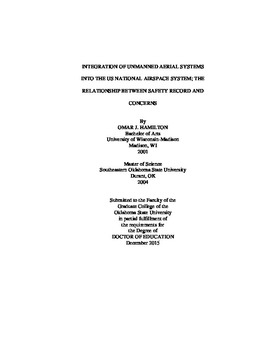| dc.contributor.advisor | Bliss, Timm J. | |
| dc.contributor.author | Hamilton, Omar J. | |
| dc.date.accessioned | 2017-02-22T22:11:17Z | |
| dc.date.available | 2017-02-22T22:11:17Z | |
| dc.date.issued | 2015-12 | |
| dc.identifier.uri | https://hdl.handle.net/11244/48904 | |
| dc.description.abstract | The purpose of this study was to discover if a relationship existed between the most common safety concerns and the most common UAS accidents with regards to the integration of the unmanned aerial system (UAS) into the National Airspace System (NAS). The study used a Mixed Method approach to find the most common causes of UAS accidents over a five-year period, the level of safety concerns and common concerns from UAS pilots and sensor operators. The quantitative data was derived from the Air Force, Navy and Army Safety Offices, while the qualitative data was derived from an online questionnaire and follow-up interviews of US Air Force UAS pilots and sensor operators. Review and observation of the data consisting of data comparison, was conducted to discover if there were any relationship between safety concerns and safety accidents. Comparison between the most common accidents during the three phases of flight and the level of safety concerns that each research subject had for accidents to occur during those phases of flight was completed. | |
| dc.description.abstract | UAS flight profiles were categorized into takeoff, cruise and landing and the most common accidents (pilot error, engine failure, loss of control and lost link), were divided into the respective phase of flight. Engine failure proved to be the most common cause for accidents while most accidents occurred during the cruise phase of flight. The USAF pilots and sensor operators' showed a slight level of concern on a scale of 1-5 with regards to accidents occurring with a UAS. Comparison showed there was a positive relationship between the number of accidents during takeoff and landing phases, which had the lowest occurrences, and a slight level of concern of accidents occurring during these phases. There was a negative relationship between the number of accidents during cruise, the highest occurrences of accidents, and the level of concern which was slight. The observed number of near midair and midair collisions were low, which showed a positive relationship with the level of concern, observed as a slight concern. These findings can be attributed to the follow-up interview in which the pilots and sensor operators did not believe safety was the biggest concern when integrating the UAS into the NAS. | |
| dc.format | application/pdf | |
| dc.language | en_US | |
| dc.rights | Copyright is held by the author who has granted the Oklahoma State University Library the non-exclusive right to share this material in its institutional repository. Contact Digital Library Services at lib-dls@okstate.edu or 405-744-9161 for the permission policy on the use, reproduction or distribution of this material. | |
| dc.title | Integration of unmanned aerial systems into the US National Airspace System; The relationship between safety record and concerns | |
| dc.contributor.committeeMember | Depperschmidt, Chad L. | |
| dc.contributor.committeeMember | Marks, Steven K. | |
| dc.contributor.committeeMember | Key, James P. | |
| osu.filename | Hamilton_okstate_0664D_14348.pdf | |
| osu.accesstype | Open Access | |
| dc.type.genre | Dissertation | |
| dc.type.material | Text | |
| thesis.degree.discipline | Applied Educational Studies | |
| thesis.degree.grantor | Oklahoma State University | |
